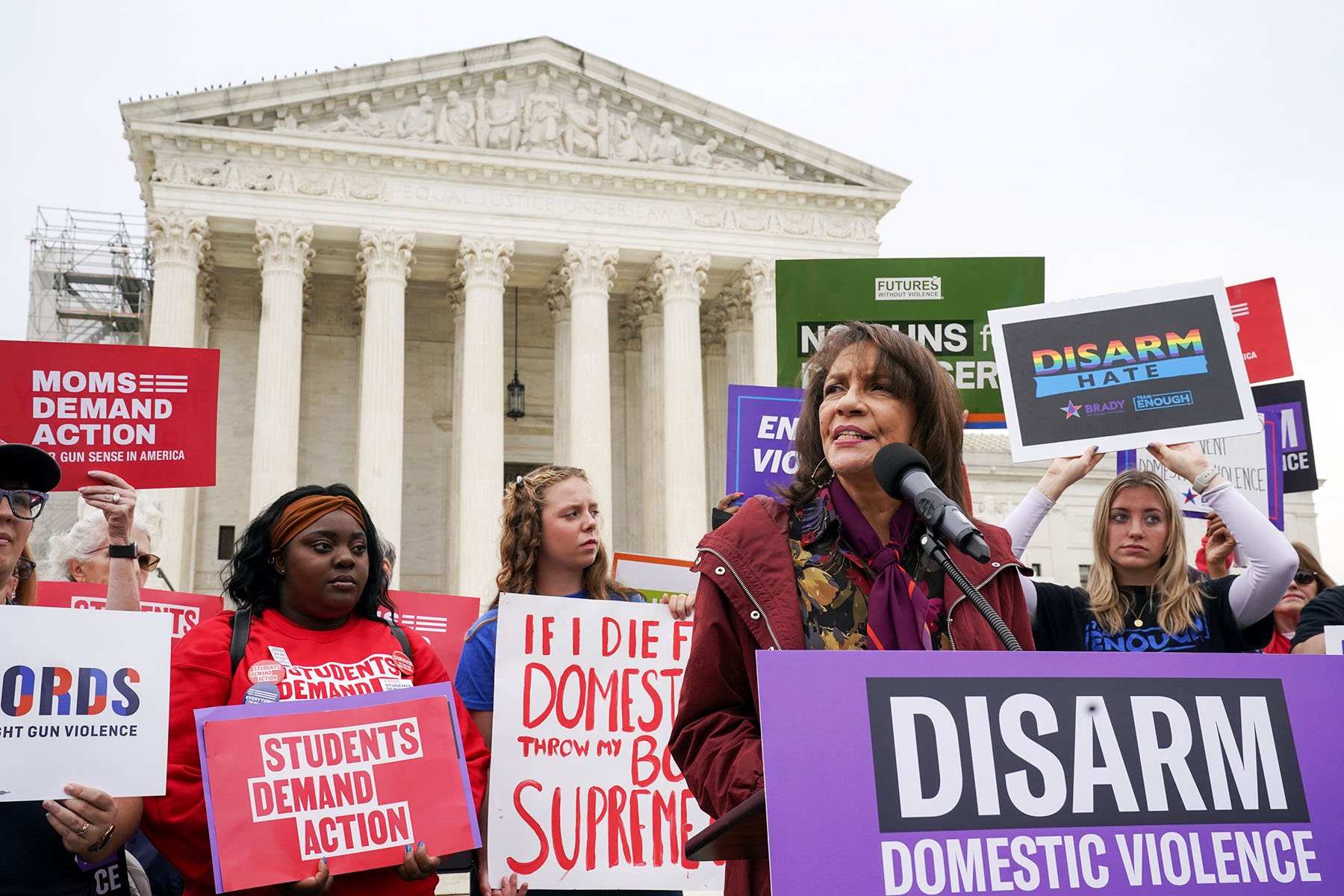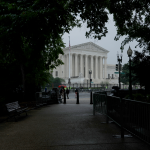Editor’s note: This article has been updated with text from the majority opinion and comment from the GIFFORDS Law Center.
The Supreme Court on Friday upheld a federal law that prevents someone under a domestic violence restraining order from possessing firearms in the case of United States v. Rahimi.
The decision was 8-1, with Justice Clarence Thomas casting the dissenting vote.
Chief Justice John Roberts wrote in the opinion, “Since the Founding, the Nation’s firearm laws have included regulations to stop individuals who threaten physical harm to others from misusing firearms.” The federal law being challenged here, he wrote, “fits within this tradition.”
In 2019, Zackey Rahimi physically assaulted his girlfriend in a parking lot in Texas and then told her that if she talked to the police about it, he would shoot her. Later, a state court granted her a domestic violence restraining order.
Rahimi then threatened a different woman with a gun and was charged with assault with a deadly weapon. He shot guns in public on five more occasions, firing an AR-15 assault rifle into the home of someone who had once bought drugs from him and shooting into the air at a fast food restaurant when a friend’s credit card was declined. When police conducted a legal search of Rahimi’s home, they found multiple firearms and rounds of ammunition.
Under a 1994 federal law, anyone with an active domestic violence restraining order against them is barred from possessing or purchasing firearms. Rahimi was charged with violating that law.
In June 2022, the Supreme Court ruled in New York State Rifle & Pistol Association v. Bruen that any restriction on firearms must be “consistent with the Nation’s historical tradition” — meaning that it must have a point of reference rooted in the time of the Constitution’s signing. At the time of America’s founding, domestic violence restraining orders did not exist — nor were women, who are disproportionately impacted by domestic violence, considered full citizens. Thomas wrote that this precedent superseded the long-standing practice of allowing the government to weigh its interest in public safety against the possibility of imposing a limitation on Second Amendment rights.
As a result of this ruling, the U.S. Court of Appeals for the 5th Circuit reversed its original conviction of Rahimi, saying a domestic violence restraining order could not be used to justify restricting Rahimi’s right to bear arms.
But Roberts found no conflict between the Bruen decision and the law that Rahimi contested. Roberts cited a 2008 gun case, the District of Columbia v. Heller, in clarifying that the fundamental right to bear arms is “not unlimited.” Furthermore, the opinion specified, the law at question in Rahimi meets the historical standard test established by 2022’s Bruen ruling as it “notably matches the similar judicial determinations required in the surety and going armed laws” consistent with how the Second Amendment was understood at the time of the nation’s founding. The limits on gun ownership imposed by the law, he pointed out, are only active while the person in question is actively under a domestic violence restraining order.
Esther Sanchez-Gomez, the litigation director at GIFFORDS Law Center, told The 19th that she isn’t surprised by the 8-1 nature of the ruling. She was in the courtroom during oral arguments and said there was a clear feeling from the justices that this case needed to come out in favor of the United States government — and the federal law it was seeking to protect.
“I think that while maybe on a principle level, some of the justices agree with a more history-focused approach, they understand that that only works to a degree, that if you create too rigid of a test that only looks backwards, we as a society can’t move forward,” she said.
Sanchez-Gomez said it is a dynamic she anticipates was especially top of mind for Justices Amy Coney Barrett, Ketanji Brown Jackson, Elena Kagan and Sonia Sotomayor. “The women on the court, I’m sure, must have been feeling that pretty intensely. I think it’s really telling of a court that is trapped between this originalist method of looking backwards and a practical reality of the world they live in.”
Regarding the lone dissent by Thomas, Sanchez-Gomez said, “Digging his heels in on this test and refusing to acknowledge that this is a sort of case that needs to come out the other way is telling of his lack of humanity on the subject.”
The other justices’ unity in putting some parameters around the Bruen standard is just as telling, Sanchez-Gomez said. The majority opinion written by Roberts points to a recognition that the vast majority of the justices felt that this was a case that should have never reached the Supreme Court — but did because of the uncertainty created by Bruen. The opinion today reads as a kind of “corrective response,” and a chance for these justices to make clear that “Bruen is not as extreme as it seemed at first blush,” she said. ”They’re having to make concessions because they live in the real world and that maybe calls out some of the failings of the originalist method to begin with.”
Other advocates felt similarly.
“Our country has stood at a tipping point, with the safety of survivors of domestic violence on the line. But today, we took a step toward protecting millions from their abusers,” said Janet Carter, senior director of issues and appeals at Everytown Law, in a statement after the decision. “This is a major victory for gun safety in the courts, but make no mistake — we should not have been here in the first place. Lower court judges should never have been allowed to put their interpretation of early American history ahead of the lives of countless women and families across the country.”
A domestic violence restraining order is a protective measure issued by a civil court. While the specifications of what these orders do can vary by state, they generally require a person accused of abuse to stop harming or threatening a victim; stay physically away from a victim’s home, workplace and school; and cease all communication with a victim. To receive such an order, an accuser must petition a civil judge and provide evidence. Civil courts’ evidentiary standard is a “preponderance of evidence,” a burden of proof below what is required for a conviction in criminal courts. If a judge finds that a preponderance of evidence shows proof of abuse, stalking, harassment or any other form of domestic or intimate partner violence, they will grant the accuser a domestic violence restraining order.
Women, LGBTQ+ people and those from marginalized backgrounds are disproportionately impacted by domestic violence. Women in the United States are 11 times more likely to be killed with a firearm than women in other high-income countries, female intimate partners are more likely to be killed with a gun than all other means combined, and the presence of a gun increases the risk of homicide for women in domestic violence situations by 500 percent. One in 4 women in the United States has been the victim of severe domestic violence injury in her lifetime, and 1 in 3 women in the United States has experienced rape, stalking or domestic violence.
“Today’s decision from the Supreme Court is a powerful reminder that the gun lobby cannot — and will not — be the arbiter of the lives of women and families across the country,” said Angela Ferrell-Zabala, executive director of Moms Demand Action, in a statement released after the decision. “Our movement has been fighting against the gun lobby’s extreme agenda for over a decade, and made it known that this decision would have had deadly consequences.”
And it’s a decision that Sanchez-Gomez said also speaks to what is happening on the ground politically, in individual states and the federal government as well.
“Many of the common-sense gun safety measures that are dying in statehouses and in Congress are ones that the majority of Americans think are important. I think the court upholding this measure hopefully serves as a green light to Congress and to statehouses and state senates across the country to move forward with that legislation, to be responsive to their democratic responsibilities, and to pass new laws — because the court is willing to uphold them.”







